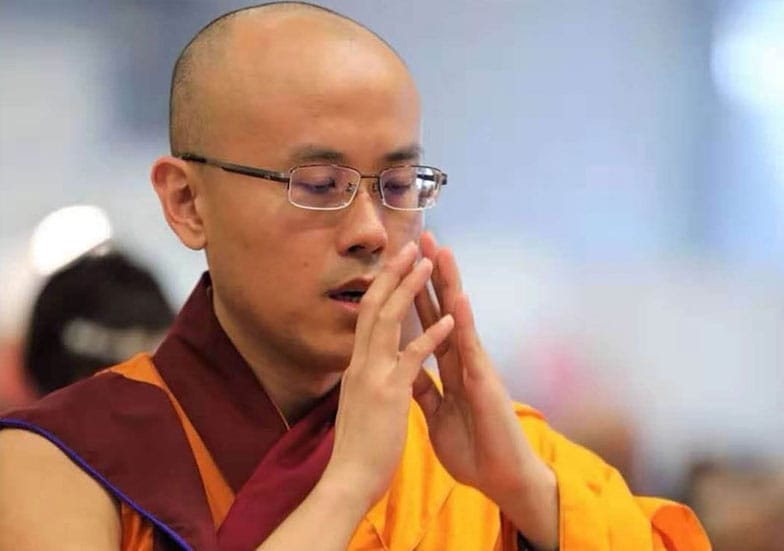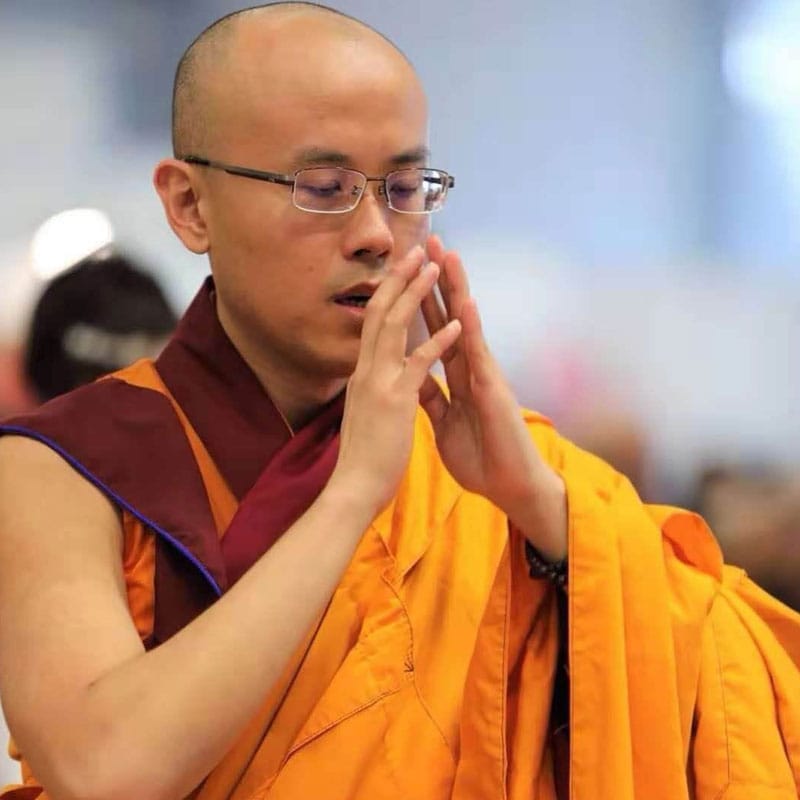
Introducing Khenpo Huiguang

Khenpo Huiguang began studying Buddhism alongside his parents at the age of six. He took refuge under several accomplished masters and elders, including Master Hsing Yun, Master Wei Chueh, Master Sheng-yen, Master Hui Lu, Master Hsing Tao, and Master Re Chang.
While still in elementary school in Taiwan, he regularly attended Buddhist camps during the summer and winter holidays. Notably, the summer after graduating from elementary school, he joined his first short-term monastic program organized by a Theravada Buddhist organization. During this retreat, he was ordained as a novice monk (samanera) for a month, gaining firsthand experience of monastic life.
A turning point came when he met Kathog Rigzin Chenpo Padma Wangchen Rinpoche by chance. This meeting sparked an immediate and profound faith in the young Khenpo. Rinpoche bestowed upon him the teaching of Lion of Speech (a Manjushri teaching). Although still a junior high school student, Khenpo demonstrated remarkable dedication-travelling between Taipei and Kaohsiung every weekend to attend both esoteric and non-esoteric Dharma assemblies presided over by Rinpoche. He also had the rare opportunity to accompany Rinpoche overseas and meet many great masters, including Khenpo Pema Tsewang and Nyoshul Khen Rinpoche.
Though he received a letter of commendation and passed the entrance exam to a top senior high school in Taichung, he chose instead to follow Rinpoche’s guidance and travel to Eastern Tibet. There, in Arizhaxiang, Serxu (Shiqu) County, he took novice vows under Khenpo Pema Tsewang. This marked the beginning of his study of the Tibetan language and monastic rituals, and his departure from formal secular education.
Due to visa issues, Khenpo returned to Taiwan. At the time, Kathog Rigzin Chenpo was building Theg Chog Ling, a retreat centre in Taichung, and preparing materials for its first group of retreatants. Khenpo was privileged to attend the official opening and undertook a 108-day retreat at the center.
Following Rinpoche’s advice once again, Khenpo returned to Arizhaxiang for a second time. During this stay, he received the empowerments of Sitatapatra (White Umbrella Goddess) and White Tara from Khenpo Pema Tsewang, as well as the oral transmission of the Tengyur from Khenpo Tsadra.
In September of that year, he traveled to Maqu County to meet Langja Rinpoche and receive teachings in Tibetan. The first of these was Instructions to Preliminary Practices (Words of My Perfect Teacher). Over time, he received numerous oral transmissions from Langja Rinpoche, including teachings on Kurukulle, the Eight Precepts, the 37 Practices of a Bodhisattva, and other esoteric and non-esoteric teachings. Notably, Langja Rinpoche was also the root guru of Kathog Rigzin Chenpo Rinpoche.
In Maqu’s Awancang Township, Khenpo came to know Ngawang Rinpoche, abbot of the local Nyingma monastery. There, at the Monastery’s Buddhist academy, he studied under Khenpo Lodro. His curriculum included: The Path of a Bodhisattva, Jewel Lamp Illuminating the Definite Understanding of the Glorious Kalachakra, Letter to a Friend, The Two Rules, Thirty Verses on Tibetan Grammar, Entrance to the Way of the Wise, and other treatises.
After fulfilling his compulsory military service in Taiwan, he returned to Tibet to visit Langja Rinpoche, Achuk Lama of Yarchen Gar, and Sangye Tsering Rinpoche of Nyoshul Monastery. In December that year, he journeyed to India to pay homage to Chatral Rinpoche, the root guru of Kathog Rigzin Chenpo. From Chatral Rinpoche, he received the oral transmission of teachings on the Thirteen Guru Emanations and Vajrasattva. Following this, he spent a month in Bodhgaya, completing 100,000 prostrations. In February 2006, he arrived in Dharamsala.
That summer, Khenpo traveled to Mura Monastery—Kathog Rigzin Chenpo’s home monastery— for a retreat. There, he attended teachings by Khenpo Chagda on Recollecting the Triple Gem, and earned second place in a Tibetan-language examination. Afterward, he traveled to Jigzhi County in Qinghai to visit Danpu Tulku’s monastery, where he stayed for a month to receive the complete oral transmission of the Tengyur.
Following Kathog Rigzin Chenpo Rinpoche’s instructions, Khenpo applied to study at the Larung Gar Five Sciences Buddhist Academy (Serta), where he studied Buddhism in the Tibetan language. His studies covered Buddhist logic (pramana), Vinaya, Prajna (wisdom), Madhyamaka, the Treasury of Abhidharma, and the Five Great Treatises. Remarkably, he was placed second in the annual Prajna examination—making history as the first non-Tibetan to pass the written exam in the Tibetan language.
After completing a retreat in four over years, Khenpo again followed his guru’s advice and undertook extensive practices of the Rigzin lineage. These included the Four Preliminaries (ngondro), Chod, Phowa, Lama Gongdu, Hell-Eliminating Vajrasattva, the Eight Herukas, Sangwa Yisie, and the Dzogchen practices of Trekcho and Togal of Dzogchen, and others.